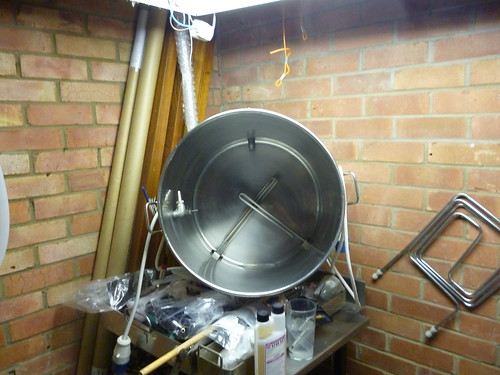5 gallons is the ideal home brewlength, or fermentation target volume. firstly because its a managable mass for a fairly fit and able bod to lump off the ground to a waist height counter top for easy gravity draining. going larger can mean splitting the brew (not a bad thing) or investment in equipment like pumps to move the beer.. And while providing a good volume, its not so large, so you will need to brew again within a few weeks, brew too much and you can reduce the number of highly enjoyable brewdays ;( also brew a not so hot beer (not that you would...) and you can be lumbered..
as you will be spending a day at the brewface

if you dont enjoy the experience, well yer not gonna pursue it are ya??
your preboil or post mash volume will be larger as it still contains the volume you intend to boil off, an initial boil can foam up quite a bit, and a rolling boil without fine power/heat control can require a few inches of pot wall to contain the brew and avoid hot sweet splashouts not so much an issue on the patio, but in a domestic kitchen you can come across sticky patches for days after which someone may take great pleasure in pointing out to you and imposing a lifetime ban on kitchen brewing, perhaps, it has happened

..
So a pot with a larger capacity is good i would suggest perhaps 10litres above your target volume so say 35l for a 5gallon brew would be the minimum kettle size i would suggest. but any size upto 50l would be good and the capacity to brew a bit more if you want to isnt that bad either..
A hlt is a luxury/optional item, not needed really imho, but if used can shave 10-20 minutes or so off the brew day.. without one you simply sparge into a big bucket or FV, and when the kettle (used to provide sparge liquor) is free simply fill it from the bucket or buckets ?
A hlt allows you to sparge straigh into the kettle and start the heat up a little bit sooner...
If using SS pots, the fitting of drain valves elements etc is generally accomplished using a Qmax hole punch, for 1/2" bsp threaded pipe fittings (the standard ) a 20-21mm hole is ideal. i use/d 20mm..
drill a pilot hole with a small drill bit 3-4mm, and expand up a few mm at a time, a dab of cutting grease is good tho sprays of wd40 from a 3rd hand is an ilequipped bods alternative, once the hole is big enough for the Qmax bolt 10mm iirc fit the punch and wind it up to effortlessly punch out a clean smooth edged burr free hole.. standard jobber HSS drill bits will work ok with thin pots, thicker SS pots will probably go thru a couple of smallest bits if drilling lots of holes and colbalt bits might be worth the investment..
and dont forget to buy an allen key if you dont have one for the qmax.. the tight gits dont include one in the pack;(
SS bulkhead fittings can be fabricated from M20 SS washers (ebay) and a 1/2" hex nipple, then wrap the hilt/shoulder of a hex nipple with a healthy wrap of ptfe tape so an m20 washer needs some force to sit snuggly round the nipples tape wrapped shoulder. this forms the outside thrust plate for the fitting.. inside the pot fit a 2nd m20 washer and any fitting you need, a simple lock nut or perhaps a fitting to mate with any hop filter or like in my case a simple 90 degree elbow to piont down and form the internal aspect of a siphon so when draining i can minimise losses to dead space to a few ml.. to make a heat and food safe sealing washer/grommet a silicone cake mould or baking sheet can be cut with scissors easily, mark out a template undersizing slightly so a 19-20mm inner hole that you will need to stretch slightly to fit over the male thread, also under cut the outside diameter by 2-3mm (i you dont under cut it will get compressed and squeeze out a bit, tho you can trim it with a razor .. under cutting just saves the hassle)
well thats my take..
my 100l kettle lwd elements and 1/2" bsp sized drain, Pt100, and recirulation return. fitted with the above technique.
have fun..









































